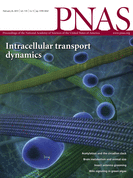张永清:发现抑制老年性痴呆病理发生潜在药物靶标
| 导读 |
阿尔兹海默病(Alzhermer’s disease, AD),又叫老年性痴呆。其主要病理变化之一是病人大脑神经元中微管结合蛋白Tau的过度磷酸化而形成神经纤维缠结。除了AD,其它多个相关神经退行性疾病的病理发生过程中也有Tau蛋白的过度磷酸化和神经纤维缠结的形成,这类疾病统称 为Tau蛋白病(tauopathy)。正常生理情况下,Tau起着稳定微... |

阿尔兹海默病(Alzhermer’s disease, AD),又叫老年性痴呆。其主要病理变化之一是病人大脑神经元中微管结合蛋白Tau的过度磷酸化而形成神经纤维缠结。除了AD,其它多个相关神经退行性疾病的病理发生过程中也有Tau蛋白的过度磷酸化和神经纤维缠结的形成,这类疾病统称 为Tau蛋白病(tauopathy)。正常生理情况下,Tau起着稳定微管的作用,但在Tau蛋白病的病人大脑中,Tau蛋白功能异常,从而导致微管结构破坏。前人的研究表明,在Tau蛋白病的转基因小鼠模型中,稳定微管的药物可以有效地挽救神经元功能异常和认知功能缺陷等表型,但上述药物具有一定的副作用。
为了寻找和鉴定抑制Tau蛋白病病理发生的互作基因和药物靶标,中科院遗传与发育生物学研究所张永清研究组将人类Tau蛋白异源表达于方便观察微管骨架的果蝇肌肉细胞中。异源表达的Tau被高度磷酸化,并且造成了微管密度的降低和网络的破坏,与AD病人和小鼠Tau蛋白病模型中的细胞病理特征相一致。通过遗传突变体筛选他们发现组蛋白去乙酰化酶(histonedeacetylase)家族成员HDAC6突变后可以有效地抑制Tau异源表达所致的微管破坏。点突变遗传互作分析和特异性抑制HDAC6微管去乙酰化 酶活性的药物处理实验显示,HDAC6突变很可能是通过提高微管乙酰化水平来挽救Tau诱导的微管破坏。上述结果揭示HDAC6可以作为治疗AD和其他相 关Tau蛋白病的潜在药物靶标。
该研究结果3月4日在线发表于PNAS (doi:10.1073/pnas.1207586110)。张永清研究组博士研究生熊英为第一作者,该研究得到了中科院和国家自然科学基金委的资助。
原文链接:
HDAC6 mutations rescue human tau-induced microtubule defects in Drosophila
Neurons from the brains of Alzheimer’s disease (AD) and related tauopathy patients contain neurofibrillary tangles composed of hyperphosphorylated tau protein. Tau normally stabilizes microtubules (MTs); however, tau hyperphosphorylation leads to loss of this function with consequent MT destabilization and neuronal dysfunction. Accordingly, MT-stabilizing drugs such as paclitaxel and epothilone D have been shown as possible therapies for AD and related tauopathies. However, MT-stabilizing drugs have common side effects such as neuropathy and neutropenia. To find previously undescribed suppressors of tau-induced MT defects, we established a Drosophila model ectopically expressing human tau in muscle cells, which allow for clear visualization of the MT network. Overexpressed tau was hyperphosphorylated and resulted in decreased MT density and greater fragmentation, consistent with previous reports in AD patients and mouse models. From a genetic screen, we found that a histone deacetylase 6 (HDAC6) null mutation rescued tau-induced MT defects in both muscles and neurons. Genetic and pharmacological inhibition of the tubulin-specific deacetylase activity of HDAC6 indicates that the rescue effect may be mediated by increased MT acetylation. These findings reveal HDAC6 as a unique potential drug target for AD and related tauopathies.
来源:中科院遗传与发育所
 腾讯登录
腾讯登录
还没有人评论,赶快抢个沙发